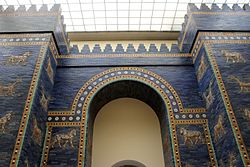
Back የኢራቅ መንግሥት Amharic المملكة العراقية Arabic Reinu d'Iraq AST عیراق کراللیغی AZB Ираҡ короллеге Bashkir Каралеўства Ірак Byelorussian ইরাক রাজতন্ত্র Bengali/Bangla Regne de l'Iraq Catalan شانشینی عێراق CKB Irácké království Czech
Hashemite Kingdom of Iraq
| |||||||||
|---|---|---|---|---|---|---|---|---|---|
| 1932–1958 | |||||||||
| Anthem: السلام الملكي As-Salam al-Malaki "The Royal Salute" | |||||||||
 | |||||||||
| Capital and largest city | Baghdad | ||||||||
| Official languages | Arabic | ||||||||
| Common languages | Arabic Assyrian Kurdish Persian English | ||||||||
| Religion |
| ||||||||
| Demonym(s) | Iraqi | ||||||||
| Government | Unitary parliamentary constitutional monarchy | ||||||||
| King | |||||||||
• 1932–1933 | Faisal I | ||||||||
• 1933–1939 | Ghazi | ||||||||
• 1939–1958 | Faisal II | ||||||||
| Regent | |||||||||
• 1939–1941 (1st time) | Prince Abdullah | ||||||||
• 1941 | Sharaf bin Rajeh | ||||||||
• 1941–1953 (2nd time) | Prince Abdullah | ||||||||
| Prime Minister | |||||||||
• 1932–1933 (first) | Naji Shawkat | ||||||||
• 1958–1958 (last) | Ahmad Mukhtar Baban | ||||||||
| Legislature | Parliament | ||||||||
• Upper Chamber | Senate | ||||||||
• Lower Chamber | Chamber of Deputies | ||||||||
| Historical era | |||||||||
• Independence from United Kingdom | 3 October 1932 | ||||||||
| 1 April 1941 | |||||||||
| 2–31 May 1941 | |||||||||
• Admitted to the United Nations | 24 October 1945 | ||||||||
• Exit of British soldiers | 26 October 1947 | ||||||||
| 24 February 1955 | |||||||||
| 14 July 1958 | |||||||||
| Currency | Iraqi dinar | ||||||||
| ISO 3166 code | IQ | ||||||||
| |||||||||
| Today part of | Iraq | ||||||||
| History of Iraq |
|---|
 |
|
|
The Hashemite Kingdom of Iraq (Arabic: المملكة العراقية الهاشمية, romanized: al-Mamlakah al-ʿIrāqiyyah ʾal-Hāshimyyah, lit. 'Iraqi Hashemite Kingdom') was a state located in the Middle East from 1932 to 1958.
It was founded on 23 August 1921 as the Kingdom of Iraq, following the defeat of the Ottoman Empire in the Mesopotamian campaign of the First World War. Although a League of Nations mandate was awarded to the United Kingdom in 1920, the 1920 Iraqi revolt resulted in the scrapping of the original mandate plan in favour of a formally sovereign Iraqi kingdom, but one that was under effective British administration. The plan was formally established by the Anglo-Iraqi Treaty.
The role of the United Kingdom in the formal administration of the Kingdom of Iraq was ended in 1932,[1] following the Anglo-Iraqi Treaty (1930). Now officially a fully independent kingdom, officially named the Hashemite Kingdom of Iraq, it underwent a period of turbulence under its Hashemite rulers throughout its entire existence. Establishment of Sunni religious domination in Iraq was followed by Assyrian, Yazidi and Shi'a unrests, which were all brutally suppressed.[citation needed] In 1936, the first military coup took place in the Hashemite Kingdom of Iraq, as Bakr Sidqi succeeded in replacing the acting Prime Minister with his associate. Multiple coups followed in a period of political instability, peaking in 1941.
During the Second World War, the Iraqi government of the Prince-Regent, Prince 'Abd al-Ilah, was overthrown in 1941 by the Golden Square officers, headed by Rashid Ali. The short-lived pro-Nazi government of Iraq was defeated in May 1941 by the Allied forces in the Anglo-Iraqi War. Iraq was later used as a base for Allied attacks on the Vichy-French-held Mandate of Syria and support for the Anglo-Soviet invasion of Iran. At the same time, the Kurdish leader Mustafa Barzani led a rebellion against the central government in Baghdad. After the failure of the uprising, Barzani and his followers fled to the Soviet Union.
In 1945, during the final stages of World War II, Iraq joined the United Nations and became a founding member of the Arab League. In 1948, massive violent protests, known as the Al-Wathbah uprising, broke out across Baghdad as a popular demand against the government treaty with the British, and with support from the communists. More protests continued in the spring, but were interrupted in May, when martial law was imposed after Iraq entered the 1948 Arab–Israeli War along with other members of the Arab League.
In February 1958, King Hussein of Jordan and Prince `Abd al-Ilāh proposed a union of Hāshimite monarchies to counter the recently formed Egyptian–Syrian union. The resulting Arab Federation, formed on 14 February 1958, was short-lived and ended the same year with a military coup led by Abd al-Karim Qasim deposing the monarchy.
© MMXXIII Rich X Search. We shall prevail. All rights reserved. Rich X Search

